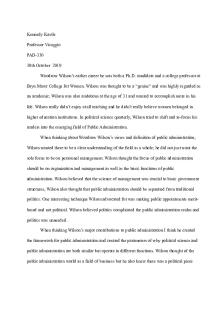Material contribution to injury PDF

| Title | Material contribution to injury |
|---|---|
| Course | Tort |
| Institution | University of Chester |
| Pages | 2 |
| File Size | 42 KB |
| File Type | |
| Total Downloads | 29 |
| Total Views | 174 |
Summary
This document provides: Material contribution to injury supported by Bonnington Castings Ltd v Wardlaw (1956), and Williams v Bermuda Hospitals Board (2016)....
Description
Material contribution to injury
There is a range of cases which deal with illness and injury in which it is known that one or more defendants have been negligent, but it is not possible to link them to the claimant’s injury accurately.
Bonnington Castings Ltd v Wardlaw (1956)
The claimant contracted pneumoconiosis due to exposure at work to silicone dust. There were two sources of the dust, one tortious (due to inadequate provision of protection by the defendant) and one non-tortious. It was impossible to attribute the disease conclusively to either source and so the but for test was of no assistance. The House of Lords ruled that this was a case in which the disease had been caused by the accumulation of dust from both sources. It was found that the dust attributable to the employer’s negligence had materially contributed to this accumulation, and thus the defendant was liable—perhaps surprisingly, for the whole of the outcome. This can be explained by the fact that the resultant disease was indivisible; a totality which could not be broken down into component elements.
Williams v Bermuda Hospitals Board (2016)
The claimant attended the defendant hospital emergency department complaining of pain. A CT scan was ordered for diagnostic purposes but there was a five-hour delay before the scan took place. His appendix ruptured, and following surgery the claimant suffered sepsis, which led to severe heart and lung damage. The negligence action alleged that had the scan occurred within a reasonable time, the damage sustained from the sepsis would have been avoided. The Privy Council concluded that the cause of the injury had been cumulative, as in Bonnington, and that it was more likely than not that the defendant’s delay had materially contributed to the resultant damage....
Similar Free PDFs

Material contribution to injury
- 2 Pages

Contribution to Management Thought
- 10 Pages

Tissue Response to Injury
- 3 Pages

02. Cellular Responses to Injury
- 7 Pages

Saussure contribution
- 4 Pages

Contribution paper
- 11 Pages

Contribution margin
- 2 Pages

Net Marketing Contribution
- 2 Pages
Popular Institutions
- Tinajero National High School - Annex
- Politeknik Caltex Riau
- Yokohama City University
- SGT University
- University of Al-Qadisiyah
- Divine Word College of Vigan
- Techniek College Rotterdam
- Universidade de Santiago
- Universiti Teknologi MARA Cawangan Johor Kampus Pasir Gudang
- Poltekkes Kemenkes Yogyakarta
- Baguio City National High School
- Colegio san marcos
- preparatoria uno
- Centro de Bachillerato Tecnológico Industrial y de Servicios No. 107
- Dalian Maritime University
- Quang Trung Secondary School
- Colegio Tecnológico en Informática
- Corporación Regional de Educación Superior
- Grupo CEDVA
- Dar Al Uloom University
- Centro de Estudios Preuniversitarios de la Universidad Nacional de Ingeniería
- 上智大学
- Aakash International School, Nuna Majara
- San Felipe Neri Catholic School
- Kang Chiao International School - New Taipei City
- Misamis Occidental National High School
- Institución Educativa Escuela Normal Juan Ladrilleros
- Kolehiyo ng Pantukan
- Batanes State College
- Instituto Continental
- Sekolah Menengah Kejuruan Kesehatan Kaltara (Tarakan)
- Colegio de La Inmaculada Concepcion - Cebu







